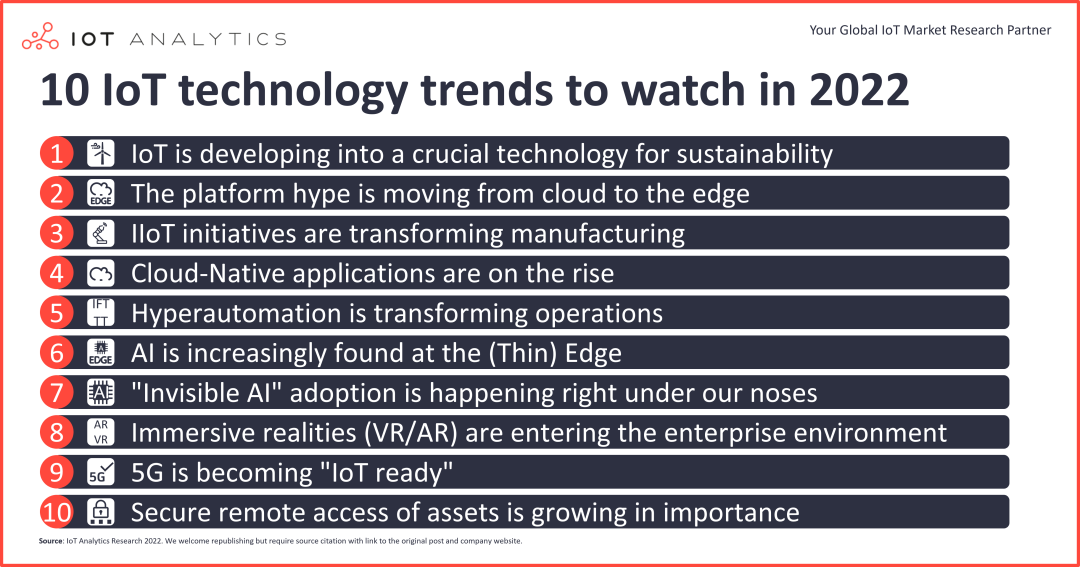
IoT becomes a key technology for sustainable development
The ability of smart connected devices to support and advance applications such as environmental monitoring, area management, and energy optimization is well known in the IoT community. However, the commercial value of these applications has been limited and has so far been marginalized by most major IoT players. With growing focus on building a green economy and mitigating climate change, IoT technologies have the potential to provide green solutions for businesses, cities and communities . These applications, including reducing energy costs, enabling remote deployments, monitoring points of failure, and more, will quickly transform from edge cases to drivers of IoT expansion. A key goal of the IoT community should be to emphasize the integration of IoT into any viable model of a sustainable global economy.
IoT platforms are moving from the cloud to the edge
Virtualization technologies such as VMs and containers enable application portability across computing hardware vendors. These technologies are widely adopted by IT departments, but many OT departments still obtain the application by purchasing the equipment that runs the application (for example, they purchase protocol converters to convert from one Ethernet protocol to another, or buy PLC to run certain control logic workloads).
At the risk of grossly oversimplifying the market landscape, edge platform vendors can be grouped by the type of hardware, cloud/IoT platform, and edge application they support. Vendors can also be grouped according to their core business: hardware vendors, cloud vendors and software vendors. Edge platforms, especially those in the industrial space, will be the breakout year for enterprises in the IoT platform race.
The Industrial IIoT Is Transforming Manufacturing
Engineers tend to look at technology as a solution, often ignoring what the root of the problem might be. The role of IoT is to go beyond SCADA (Supervisory Control and Data Acquisition) for machine operations by providing the data needed to make timely decisions about maintaining assets. In the recent past, an IoT project was simply a digital process. More data is now accessible, and data provided by IoT projects can now be used to predict machine problems and automatically guide technicians to solutions that optimize production .
Cloud native applications are on the rise
Nowadays, more and more enterprises regard cloud application and business cloud as the top priority, and this trend will continue to develop in the next few years. Those enterprises that have already invested heavily in the cloud are looking for ways to improve efficiency and increase cloud capabilities, while other enterprises need to quickly complete cloud business migration. Over the past ten years, the cloud computing market has been growing at a steady rate, and the epidemic has also accelerated its overall application and implementation.
With the normal development of cloud at the infrastructure, platform and software levels, the industry will see applications developed and optimized for the scale and performance of cloud computing , which will help improve the reliability of cloud computing and shorten deployment time, It also means that software applications can be deployed faster and more flexibly, while reducing infrastructure complexity and cost .
Hyperautomation is transforming operations
The traditional view is that artificial intelligence is the key to changing any enterprise application, but the actual situation is not the case. At present, in most industries, artificial intelligence needs to dig deep into the value of data to make real benefits for enterprises. AI is only one part of enterprise transformation. The other part, which is often overlooked by enterprises, is robotic process automation (RPA). When AI and RPA are properly combined and applied, the result is hyperautomation . Integrating AI into applications to make decisions for RPA is the ultimate extension of IFTTT.
COVID-19 has created an inflection point prioritizing worker safety and the technology support it needs, while labor shortages that began before COVID-19 have become more challenging constraints, accelerating the use of hyperautomation to optimize Business process from factory floor to management.
AI is increasingly at the edge
Enterprises have been thinking about deploying their AI in the cloud or at the edge. So far, AI at the edge has been running on compute and power-intensive edge devices, such as industrial computers and edge routers. However, there are two development trends that are driving the transformation of artificial intelligence to the more edge side:
With the rapid development of low-cost, low-power semiconductors, artificial intelligence can be brought closer to the smallest level of equipment. There is every reason to believe that a large number of microcontrollers (MCUs) will deploy on-device AI in the near future.
Over the past 5 years, AI algorithms have become more efficient. For example, current AI algorithms require far less computing power than a few years ago to perform visual object recognition on neural networks. Experts predict that the required computing power will be reduced by a factor of 2 every 16 months.
We will increasingly see AI applications moving to thin edge devices that run on MCUs with memory, computing power, and low power consumption.
The application deployment of stealth artificial intelligence is getting closer to the user
The applications of AI are vast, spanning every industry and impacting nearly every job function, from the bottom line employee to the CEO. With so many companies now including AI in their products, platforms, and services, AI is starting to permeate our lives in more ways than we realize , often right under our noses, whether we realize it or not, AI is all being used to help us.
Immersive reality (VR/AR) is entering the enterprise environment
Although humans have realized working and living in intelligent environments, researchers and enterprises are currently looking for more efficient and effective ways of living/working in intelligent spaces. This means that while improving the operational efficiency and quality of the working environment, it is also necessary to develop remote operation management, and the new crown epidemic has undoubtedly further strengthened the industry's attention to remote operations.
For this reason, the integration of the Internet of Things, immersive reality technology and environmental simulation technology (such as digital twins) is the general trend , but the integration of the two will require a large amount of data support, so the rapid development of 5G and edge computing will accelerate the development of enterprises and industries. Applied VR/AR application development.
5G is ready for IoT applications
Consumer-oriented experts believe that 5G simply provides a faster download mechanism. And its value in the industrial and commercial fields is reflected in the 5G private network. By the end of 2022, with the popularization of 5G, it will be just a tool rather than a pioneering technology, only to solve the pain points of the industry and help enterprises reduce costs and increase efficiency. Predictable wireless performance and the real-time capabilities of 5G hold great potential for smart factories in the not-too-distant future.
Secure remote access to assets is becoming increasingly important
Companies that enable remote access to equipment will enjoy several benefits, including better technical support from equipment suppliers, the ability to remotely troubleshoot and analyze machine data in real-time, remote expert guidance, and low-cost labor. But as the number of visits increases, the entry points for network security attacks also increase, so companies immediately increase their spending on network security. Three key applications of network security are asset visibility, deep packet inspection, and zero trust architecture.
In short , the 10 trends released by IoT Analytics focus on 3 main dimensions:
The digital transformation of the production process in the industrial field will continue, and more and more AI will be deployed on the edge side;
In the field of IoT platform and software, with the improvement of cloud computing capabilities, cloud-native applications are on the rise, and platform deployment is also migrating to the edge side;
The industry will also pay more attention to the security protection of IoT devices and data.
Past recommendation
☞ IDC China 2022 IoT Platform Evaluation Report
☞ IoT Platform Trends in 2022: Privatization
☞ 5 failed lessons worth sharing about Internet of Things startups
☞ Selection and comparison of four domestic IoT platforms
☞ Is the [IoT platform] of cloud vendors not popular?




